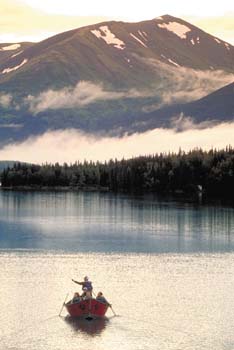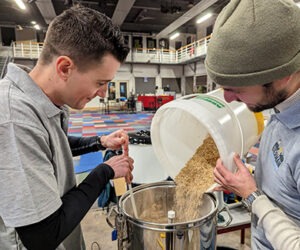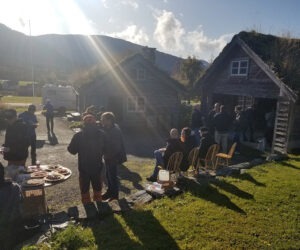Alaskan Homebrewing
The Alaskan Gold Rush in the late 1800s brought breweries to the southeastern part of the state to help quench the thirst of the miners. Over 100 years later, while most of the gold might be gone, brewpubs, microbreweries and homebrewers are there to stay.
“The Gold Rush brought people to Alaska, and the people brought their desire for beer and other beverages,” says Pete Devaris, a local homebrewer with a passion for spruce beer.
This big state with a small population has kept a big appetite for all things beer. The U.S. Census Bureau estimated the 2003 Alaskan drinking-age population to be around 420,000. Despite these numbers, the state has been able to support 12 microbreweries and brewpubs, according to Anchorage Press beer columnist James Roberts, who’s known as Dr. Fermento to his readers. In addition, the greater-Anchorage area supports quite a saturated beer information market, with two beer columnists who tap out a total of 78 installments of their columns annually.
“It’s a pretty incestuous industry,” says Roberts. “If you take my 52 pieces, and Dawnell Smith’s 26 for the Anchorage Daily News, plus occasional coverage by other media types and divide it by the [Anchorage] population — 265,000 — that’s a pretty big interest.”
Homebrewer’s Paradise
Locals all agree that the homebrewing scene thrives despite the distance from the U.S. mainland. “We’ve got the best homebrew shop I’ve ever been to,” says homebrewer Jason Ditsworth, a past president of the Anchorage-based Great Northern Brewers Club (GNBC). “People come up here all the time and say, ‘Man, I wish I had place like this!’ Arctic Brewing Supply, the store, has got a mailing list of like 1,000 people, and our club [the GNBC] has 150 members.”
And homebrewing, like pretty much everything else in Alaska, is done just a little bit different from how people do it in the lower 48.
“Homebrewing has always been a steady thing up here,” says GNBC member Breck Tostevin. “People like to make their own things. There are all sorts of adventurous people in Alaska.” Roberts agrees. “To live here, you have to be different, you have to be a survivalist, a bolder soul,” he says. “We’re not afraid to experiment, break limits and brew different styles.”
Two unusual styles that have become especially prominent in Alaska are smoke-flavored beers and spruce beers.
Spruce on the Loose
Spruce beers have a rich history as America’s oldest indigenous style, according to Devaris. He says the pilgrims began the style as a way to make easy, inexpensive beer.
“They didn’t have barley or hops, and other typical ingredients were expensive to import from England,” he says. “They were desperate to make beer out of anything they could get their hands on, and spruce worked perfectly because it was free, abundant and full of sugar.”
Gold miners, on the move up the West Coast, were likely forced to use spruce in their beers for the same reasons.
“Spruce is a regional item,” Devaris says, “and you won’t find any of it in the Great Plains or say, Kansas. However, once you hit the West Coast, it’s everywhere from Kodiak Island down to southern Oregon. All around that route, miners traveling up to Alaska were surrounded by spruce, so the style’s prominence here clearly goes back to the Gold Rush days in southeast Alaska.” Devaris says the tips of the trees, when harvested and used correctly, impart a “floral, orangey, citrus flavor on the beer.”
“Real spruce beers use tips harvested in a seven to 10 day window in springtime,” he says. “However, there have been a lot of attempts to brew them without the connection to their history, and to make them any other way can be wretched.”
Hence, Devaris’ calling. “I’m just trying to revive the style,” he claims, modestly. “The misinformation on the Internet and elsewhere has hurt the style. People think it’s going to taste piney and resiny like PineSol, but it really tastes nothing like that, if made correctly.” Devaris has used spruce tips in all sorts of styles.
“I try to showcase the spruce in light, less hoppy beers, but will use it in everything from Russian Imperial Stouts to Bohemian Lagers,” he says. “It lends itself to many styles, but once you get into big heavy stouts, the flavor is less descript.”
Smokey the Beer
And while Alaskan homebrewers don’t limit themselves to brewing only certain styles, another “very Alaskan” style, according to Devaris and others, is smoke-flavored beer. This style, like spruce, has an historical appeal to brewers and drinkers alike.
“In the 1400s and 1500s, the only way brewers could get their wet malt to dry was by heating it,” says homebrewer Steve Schmitt. “They couldn’t separate the heat from the smoke, so historically, all beers were smoky. Finally, in industrial times, they could heat malt without the smoke.”
The renewed interest in the style came both from Alaskans who smoke meats and fish, and from a tasty Smoked Porter created by the Alaskan Brewing Company, based in Juneau. Smoke-flavored beers also have a history in Germany, where cities such as Bamberg are known for their rauchbiers.
There are two different ways to make a smoked beer, according to Tostevin. “You can either buy the rauchmalt from Germany, or you can make your own,” he says.
Schmitt, like many Alaskans, prefers to smoke his own malt. “I use a fish smoker,” he says. “You put wet grains on it, and it holds the smoke that is then permeated into the grain.”
Smoking beers is “unbelievably easy,” according to Schmitt, “but to make a good one is different. There’s a lot of art to it.”
The main type of wood used to smoke beers among Alaskans is alderwood, which is found in the Pacific Northwest. Other woods commonly used are applewood, birchwood and beechwood, the last of which is the main type used in German smoked beers.
One tip the smoke brewers have to offer is a simple one: Don’t make a beer too smoky! “Since smoke can create an astringency, one of the changes we usually do is to mellow the hops and lower the hopping level,” says Tostevin. “The real key is balance. A lot of people overdo the smoke, and that can cause some problems.”
Tostevin maintains that smoked beers are generally an acquired taste. “We have a fireman in the club, and he doesn’t like to associate fire or smoke with his beer,” Tostevin says. To others, smoked beers stir up memories of campfires and the outdoors, which are staples of local homebrew club events.
“Alaskans don’t like to be cooped up inside,” says Roberts. “Even in the winter, if we have the opportunity to do anything outside that would be easier or more comfortable to do inside, we’ll choose to do it outside.”
RECIPES
Rauchbear
by Mark Ryan
(5 gallons/19 L, all-grain)
OG = 1.058 FG = 1.016
IBUs = 11 SRM = 21 ABV = 5.7%
This beer took First Place in the Classic Rauchbier category at the 2001 Alaska State Fair Homebrew Competition.
Ingredients
- 3.0 lbs. (1.4 kg) DeWolf Cosyns Pilsner malt 3.75 lbs. (1.7 kg) Weyermann’s smoked malt
- 3.5 lbs. (1.6 kg) Weyermann’s Munich malt (6 °L)
- 1.25 lbs. (0.57 kg) Carapils malt
- 1.25 lbs. (0.57 kg) Caramunich® Malt (75 °L)
- 4 AAU Spalt pellet hops (30 mins)
- (1 oz./28 g of 4% alpha acids)
- Wyeast 2206 (Bavarian Lager) yeast
Step by Step
Prepare mash using 1 tsp. lactic acid. Mash all grains for 60 minutes at 154 °F (68 °C). Sparge to brewkettle, adding 1 more tsp. lactic acid to the sparge. Heat wort toward boil. Boil for 60 minutes, add Spalt hops after 30 minutes. At end of boil, remove from heat and chill wort. Pitch yeast and primary ferment for 14 days at 52 °F (11 °C), then secondary ferment for 14 days at 65 °F (18 °C), both in glass. Artificially carbonate in soda kegs.
Birch Sap Lager
by Jay Levell
(5 gallons/19 L, extract)
OG = 1.052 FG = 1.013
IBU = 37 SRM = 3 ABV = 5.1%
(stats do not take birch sap into account)
This recipe is from the Specialty/-Experimental/Historical category of the GNBC recipe book and is of local
interest.
Ingredients
- 5.8 lbs. extra light dried malt extract
- 6.9 AAU Northern Brewer whole hops (60 mins)
- (0.76 oz./22 g of 9% alpha acids)
- 4.0 AAU Hallertauer whole hops (30 mins)
- (1.0 oz./28 g of 4% alpha acids)
- 5.0 gallons (19 L) birch sap
- White Labs WLP820 (Octoberfest/Märzen) yeast
Step by Step
Heat birch sap slowly and bring to boil. Add malt extract. Bring to boil. Total boil time is 60 minutes. At boil, add Northern Brewer hops. Pitch Hallertauer hops at final 30 minutes of boil. At final 15 minutes of boil, add Irish Moss for clarity. At end of boil, chill wort and pitch yeast. Primary ferment for 10 days at 63 °F (17 °C) Secondary ferment for 2.5 months at 46 °F (7.7 °C). Cold filter and serve from a keg.




